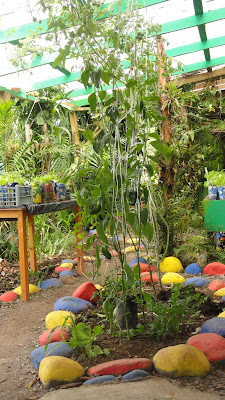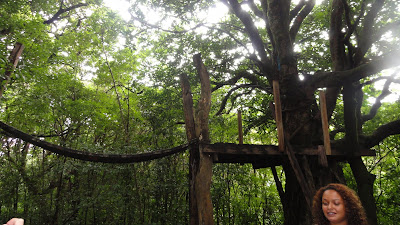Escuela Creativa
The Cloud Forest School was like no other school I have ever seen! When we pulled up the mountain and got out, this so called “school” looked like a beautiful summer camp. It was on top of one of the many green mountains here in Monteverde and it overlooked the mountain range. We were greeted by the Sobria, who organized groups coming to visit this incredible school. There were different buildings that made up the school all separated by trails and grass. There was an immediate trusting atmosphere when we were told we could leave our book bags on the picnic table outside the office.
We took a tour around and I was amazed to see how “green” this school really was. Each grade had a row of plants and when the fruits that are grown are ripe, everyone picks the fruit and takes a plant home to continue growing at their own homes. The goal, we were told, is to teach the students how to be self sufficient and be able to live off the land. They even make their own compost with the food that they would normally throw away. There were windmills and solar panels as well that did not work all the time because of their rainy season but it helps the school during their summer season.
The greenhouse we were shown by Eduardo, the man that was in charge of the landscaping, was unbelievable. Eduardo told us that they teach the students how important indigenous plants are to the environment and every plant that was in the greenhouse was native to Costa Rica. As we walked around the campus some trees had book-like laminated pages with information on them and we were told when a new plant is added, the students are responsible for updating these books and adding new pages. The school even had trails that ranged from a five minute walk to a 6 hour hike to the top of Monteverde.
 |
| The Greenhouse |
The inside of the classrooms were even intriguing. It was exactly what my “dream classroom” would look like. There were many colors, pictures and artwork all over the room. There were even things hanging from the ceiling! I loved all the student’s artwork that was decorated the walls of all the entire school. When we peeked in some classes, the teachers were teaching in English. My 12 year old hermano tico, Daibe, attends the Cloud Forest School and when I talk to him at home it is not like talking to a normal middle school aged student. There was no negative intonation in his voice about the school and when I asked him if he goes on a lot of hikes he responded “yes!” The classes that aren’t even related to science are sometimes spent outside in one of the school’s two kiosks. They have mini courses that include yoga, meditation, gardening (Eduardo is the instructor) and others.
This school has so many features that are beneficial to the students and the community around them. First off, they are teaching the students to be environmentally friendly by little things like making organic compost and planting new trees to help with the reforestation. This will benefit them the rest of their lives and it is something they can share with others. Continuing with my hope to build a community-based classroom, I want to incorporate this environmentally conscious mindset. It not only is good for the person that is giving back to the earth but for everyone in the world! The colorfulness of the classrooms is another aspect I plan on incorporating in my classroom. Learning in an aesthetically pleasing environment is much more enjoyable than a dull boring classroom. Having the students decorate rooms and hallways with their own creations will also make the students feel like they are proud of their work because it will be displayed. Doing unexpected lessons like taking short walks and using the resources around me wherever I end up teaching will make all the difference in my plans because the students will be engaged. It is almost like a trick to get the students to learn. If you can disguise something as looking like a game or going to see a really interesting animal while teaching, the students will learn without realizing it!
 |
| My Dream Classroom |
After knowing that it was a private school, I figured that only the “richer” students of Costa Rica was able to afford this dream-like school. I was surprised when we were told that the majority of the school is not only Ticos but are able to attend the Escuela Creativa because of scholarships and a few sponsorships. Sobria even told us that if a student wants to attend, they will find a way to make it happen. The diversity in the school is another beneficial feature of the Cloud Forest School. They are preparing their students to be global citizens by accepting many exchange students and the local Ticos as well. Some are richer than others and some come from different countries but they are all a part of making the earth a better place and that is so important for the youth of today. It demonstrates how making the earth a greener planet does not just affect the country you might live in, but every country and ocean on the planet.
Visiting this school also opened my eyes to different options that I have in school or after I graduate. Sobria explained to us that there are many people that come to teach there from the United States either as interns or as first or second year teachers. UNCW does not allow internships abroad except Belize, Kuwait and South Africa. Maybe that will change but even if it doesn’t, being able to teach their as a rookie teacher would take what I have learned and discovered in the past three and a half weeks and build on it making me a much better teacher.
 |
| 6th grade service project for the school: rebuliding the tree house |
The Cloud Forest School was like nothing I have ever seen before or even heard about. They are doing such great things at this school and if I am not able to go back and teach there, I at least want to go back and visit and help send funds to allow the children that want to be a part of what is happening there the chance and opportunity to be.













